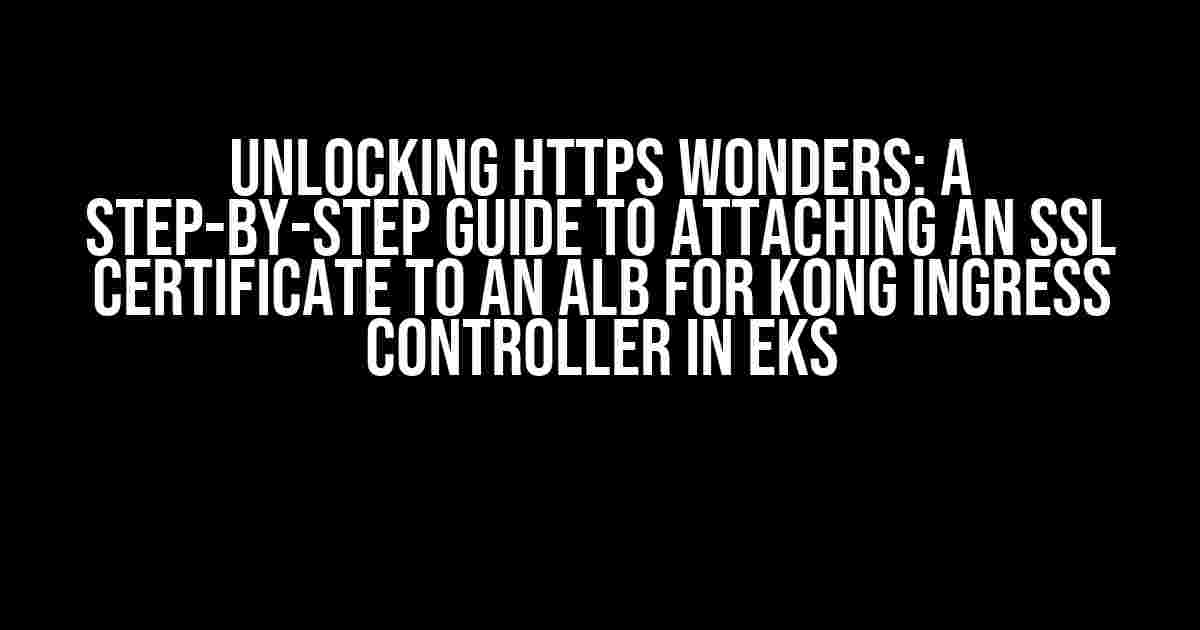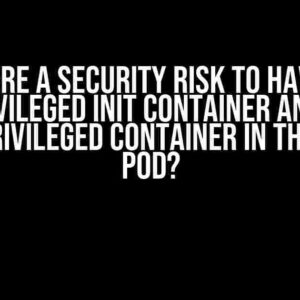Are you ready to take your Kubernetes cluster to the next level by securing your application with SSL/TLS encryption? Look no further! In this article, we’ll navigate the process of attaching an SSL certificate to an Application Load Balancer (ALB) for Kong Ingress Controller in Amazon Elastic Container Service for Kubernetes (EKS). Buckle up, and let’s dive into the world of HTTPS!
- Prerequisites
- Step 1: Create an SSL Certificate in AWS Certificate Manager (ACM)
- Step 2: Create an IAM Role for the ALB
- Step 3: Create an Application Load Balancer (ALB)
- Step 4: Attach the SSL Certificate to the ALB
- Step 5: Update the Kong Ingress Controller Configuration
- Step 6: Test Your HTTPS Connection
- Conclusion
Prerequisites
Before we begin, make sure you have the following:
- A running EKS cluster with Kong Ingress Controller installed.
- An SSL/TLS certificate issued by a trusted certificate authority (CA) or self-signed for testing purposes.
- Access to the AWS Management Console.
- Familiarity with AWS CLI or an equivalent tool.
Step 1: Create an SSL Certificate in AWS Certificate Manager (ACM)
First, we need to create an SSL certificate in AWS Certificate Manager (ACM). If you already have a certificate, skip to the next step. Otherwise, follow these steps:
- Log in to the AWS Management Console and navigate to the ACM dashboard.
- Click on “Import a certificate” and select “Request a certificate.”
- Choose “Request a public certificate” and provide the required information.
- Validate your domain ownership and wait for the certificate to be issued.
Once the certificate is issued, make a note of the certificate ARN, which will be used later.
Step 2: Create an IAM Role for the ALB
We need to create an IAM role that grants the ALB permission to assume the role and access the SSL certificate. Follow these steps:
- Go to the IAM console and click on “Roles” on the left-hand menu.
- Click “Create role” and select “Custom role.”
- Choose “EC2” as the service that will use the role and attach the policy “AmazonElasticLoadBalancingServiceRolePolicy.”
- Name the role, e.g., “alb-ssl-role” and create it.
Step 3: Create an Application Load Balancer (ALB)
Now, let’s create an ALB that will use the SSL certificate:
- Go to the EC2 console and navigate to the “Load Balancers” tab.
- Click “Create Load Balancer” and select “Application Load Balancer.”
- Choose “Internet-facing” and select the VPC and Subnets for your EKS cluster.
- Configure the security group and select the IAM role created in Step 2.
- Name the ALB, e.g., “kong-alb” and create it.
Step 4: Attach the SSL Certificate to the ALB
It’s time to attach the SSL certificate to the ALB:
- Go to the EC2 console and select the ALB created in Step 3.
- Click on the “Listeners” tab and click “Add listener.”
- Choose ” HTTPS” as the protocol and select the SSL certificate created in Step 1.
- Configure the default action and save the listener.
Step 5: Update the Kong Ingress Controller Configuration
We need to update the Kong Ingress Controller configuration to use the ALB:
- Connect to your EKS cluster using kubectl.
- Update the Kong Ingress Controller configuration using the following command:
kubectl patch ingressclass kong -p='{"spec":{"config":{"alb": {"enabled": true, "defaultCertificate": {"arn": ""}}}}}' Replace
with the ARN of the SSL certificate created in Step 1.
Step 6: Test Your HTTPS Connection
Finally, let’s test our HTTPS connection:
- Get the DNS name of the ALB using the following command:
aws elbv2 describe-load-balancers --load-balancer-arns
--query 'LoadBalancers[0].DNSName' Replace
with the ARN of the ALB created in Step 3. - Use a tool like curl to test the HTTPS connection:
curl -v https://<alb-dns-name>
Replace
with the DNS name obtained in Step 6.1.
| What to Expect | Result |
|---|---|
| HTTPS Connection Established |
|
| Certificate Verification |
|
Conclusion
Voilà! You’ve successfully attached an SSL certificate to an ALB for Kong Ingress Controller in EKS. Your application is now secured with HTTPS, providing an additional layer of protection for your users. Remember to monitor your SSL certificate expiration and renew it accordingly to avoid any security vulnerabilities.
Troubleshooting Tips
If you encounter issues, check the following:
- Verify the SSL certificate ARN and ensure it’s correct.
- Check the IAM role and policies to ensure the ALB has the necessary permissions.
- Verify the Kong Ingress Controller configuration and ensure the ALB is properly referenced.
- Check the EKS cluster and Kong Ingress Controller logs for any errors or warnings.
By following this guide, you’ve taken a significant step towards securing your application with HTTPS. Keep exploring and stay ahead of the curve in the world of cloud-native security!
Happy securing!
Frequently Asked Question
Get the inside scoop on attaching an SSL certificate to ALB for Kong Ingress Controller in EKS!
What is the main benefit of attaching an SSL certificate to ALB for Kong Ingress Controller in EKS?
The main benefit is to ensure end-to-end encryption between clients and your Kubernetes cluster, thereby providing a secure connection for your users. This is especially crucial for protecting sensitive data and maintaining trust with your customers.
What type of SSL certificate do I need to attach to ALB for Kong Ingress Controller in EKS?
You’ll need an SSL/TLS certificate issued by a trusted certificate authority (CA). You can either obtain a free SSL certificate from Amazon Certificate Manager (ACM) or bring your own certificate from a third-party provider.
How do I create an SSL certificate for my Kong Ingress Controller in EKS?
To create an SSL certificate, you can use the AWS CLI command `aws acm request-certificate` to request a certificate from ACM. Alternatively, you can use a third-party provider like GlobalSign or DigiCert to obtain a certificate. Make sure to follow their instructions for creating and managing certificates.
How do I attach the SSL certificate to my ALB for Kong Ingress Controller in EKS?
To attach the SSL certificate, you’ll need to create an SSL listener on your ALB and associate it with the certificate. You can do this using the AWS Management Console, AWS CLI, or SDKs for your preferred programming language. Make sure to update your Kong Ingress Controller configuration to reference the new SSL listener.
What are some common errors I might encounter when attaching an SSL certificate to ALB for Kong Ingress Controller in EKS?
Some common errors include certificate validation failures, incorrect certificate formatting, and misconfigured SSL listeners. Be sure to check the AWS documentation and Kong Ingress Controller logs for troubleshooting guidance, and double-check your certificate and ALB configuration.


